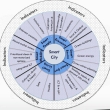Smart Cities
5. Feb. 2013
The Smart City concept is important throughout Europe and across the world, thus it is a topic in international discourse. However, this short article primarily deals with matters of local developments in Vienna and Austria; readers from Austria may prefer the full version of the article in German.
At present social innovation and everything considered 'smart' seems to boom: A major part of about 40% of all moble phones sold by the end of 2012 are smartphones. According to the Europe 2020 Strategy the European Union favours sustainable, inclusive and smart growth. Smart specialisation is supported to advance regional development, and since a few years smart cities became a hot issue too.
The first world-wide ranking of smart cities was published by Boyd Cohen, an american climate strategist, in early 2012. It lists Vienna in top position, ahead of Toronto, Paris and New York. This proves once more the high quality standards Vienna enjoys, after having been ranked most liveable citiy in the world during a number of consecutive years by Mercer. In a comparison of 70 middle-sized cities (populations between 100,000 and 500,000) in Europe, Linz, Salzburg, Innsbruck and Graz took places 9, 10, 12 and 13 (lead by frontrunners Luxemburg, Aarhus and Turku).
As with all rankings, exact positions are debatable, and there may be or will be studies producing different outcomes. Nevertheless, Austrian cities obviously seem to be well off, appearing notably 'smart'. However, what in particular depicts a smart city? Austrian experts in urban research and spatial planning, lead by Rudolf Giffinger (Vienna University of Technology), who initiated and co-ordinated the research on the 70 European cities, define smart cites according to six specific characteristics. These characteristics are combined for analysis by addressing a great number of specific factors and indicators (cf. the grafic design 'Smart Citiy Wheel', by Boyd Cohen):
- Smart People – embrace creativity, inclusive society, 21st century education
- Smart Mobility – integrated ICT, prioritized clean and non-motorized options, mixed-modal access
- Smart Living – culturally vibrant & happy, safe, healthy
- Smart Environment – green buildings, green energy, green urban planning
- Smart Economy – entrepreneurship and innovation, productivity, local & global interconnectedness
- Smart Government – enabling supply & demand side policy, transparency and open data, ICT & e-government
Cities do not upgrade in 'intelligence' by smart technolgies alone. It rather is a matter of how technologies are implemented and used, depending on dominant social practices in the manyfold and highly complex sub-systems a modern city consists of. In order to allow the unfolding of creativity, to facilitate a vibrant culture, social inclusion, and education standards and qualities required, a particular culture of innovation is essential - ready to value and support social innovations just the same as technical and commercial innovations.
Social innovations favour new opportunities to act in the characteristic domains of smart cities, as there are smart people, mobility, living, environment, economy and government. In all sectors, new and effective practices become imperative to cope with existing and emerging societal challenges. In analogy to how J.A. Schumpeter conceptualised 'innovation' one hundred years ago, namely as 'new combinations of production factors', 'social innovations' may be conceived 'new combinations of social practices'.
New practices, e.g. in moving around in a city, may be changed bottom-up (for example by increased use of bicycles), or by setting novel norms top-down. A significant case of the latter is represented by the recent enforcement of parking space management (extending time zones with liability to pay to most parts of the city territory). Besides opening up fundamental new opportunities or capabilities to act, re-combinations of existing practices may produce social innovations. A case of such re-combination of practices can be seen in the implementation of the city-bike system (in Vienna: 2003), which actually complements features of the smart city very well.
Mixed-modal access could become further improved by extending the public transport system by introducing a city-car system, using a fully electric vehicle similarly like the city-bike system. City cars of this kind should belong to and serve as an extension of public transport. In this regard, Deutsche Bahn tests since short an electric vehicle, developed with very special properties in Spain (Basque country), to supplement the Deutsche Bahn urban network in Berlin. Hiriko ('urban' in basque) is high-tech in regard of its development and performance on the one hand, yet low-tech concerning production and maintenance on the other. For parking it may even be folded up, and can turn standing in circle (Video, 1:30 min.).
As outlined in my presentation at the GFF - Science Forum (with Federal Minister of Transport, Doris Bures), Hiriko could be a good choice for Austrian cities like Vienna, Linz, Salzburg, Innsbruck and Graz to take next steps in becoming even more of a smart city.
Downloads:
Related Articles:
- News: Recommendation by ZSI: EC seeks the next European Capital of Innovation
- News: ÖGZ: Soziale Innovation als Instrument der Stadtentwicklung
Tags: smart city, social innovation















































